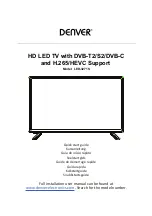
15
PICTURE IMPROVEMENT - PHILIPS TDA 9178.
The picture improvement IC is an analogue video processor offering three main processing functions; luminance vector, colour
vector and spectral processing. Features presently being implemented are; luminance transient improvement (LTI), colour transient
improvement (CTI), variable gamma control and picture dependant non-linear Y and U, V processing by luminance histogram
analysis.
The spectral processor provides luminance transient improvement, luminance detail enhancement by smart peaking and colour step
improvement (CTI). The linewidth control may be user defined. The luminance vector processor, the transfer function is controlled in
a non-linear manor by histogram analysis of measured luminance values measured in a picture. As a result the contrast ratio of the
most important parts of the scene will be improved. A variable gamma function after the conversion offers the possibility of
alternative brightness control or factory adjustment of the picture tube.
The following functions sharpness, noise reduction and colour transient improvement (CTI) are provided by the picture improvement
IC for digital models, while 100Hz/progressive scan models provide these functions within the double scan module. All functions
described are switchable/adjustable via I
2
C control using the options in the service menu.
Y, U and V signals are taken from I200 pins 49, 50 & 51 and go straight into Y
in
U
in
and V
in
(pins 6, 8 and 9 of IE01). The enhanced
Y, U & V outputs originate from IE01 (pins 19, 17 & 16 respectively) and are directed to IE02 (pins 28, 27 & 26 respectively).
TUNER.
The tuner U100, is a frequency synthesis type with an unbalanced input, powered from the +5V rail while the tuning voltage is
supplied by the +33V rail, supplied from the horizontal deflection circuit. Direct frequency access, channel selection, AGC and AFC
functions are controlled via the I
2
C bus. AGC, AFC and Offset controls may be selected by entering the service menu and selecting
the ‘tuner’ option.
Pin 1, AGC is taken from pin 62 of TDA 9320. The balanced I.F. output is taken from pins 10 & 11, which are then arrive at both the
inputs of the vision and sound SAW filters (pins 1 & 2). The outputs from X200 and X202 (pins 4 & 5 respectively) pass through to
pins 2 & 3 and pins 63 & 64 of I200, where they are demodulated.
RGB PROCESSOR - TDA 9330.
VERTICAL DEFLECTION & GEOMETRY CONTROLS.
The drive circuit for the vertical and E-W deflection circuits are generated by means of a vertical divider which gets its clock from the
line oscillator. The divider is synchronised by the incoming vertical pulse, generated by the input processor or the feature box.
The vertical drive is realised by means of a differential output current. The outputs must be DC coupled to the vertical output stage.
The vertical geometry can be adjusted by I
2
C control via the service menu.
HORIZONTAL SYNCHRONISATION & DRIVE CIRCUIT.
The horizontal drive signal is obtained from an internal VCO which is running at a frequency of 13.75MHz. This oscillator is
stabilised to this frequency by means of a resonant oscillator 12 MHz. The internal VCO is synchronised to the incoming horizontal
H
d
pulse by means of a PLL with an internal time constant. The horizontal drive signal generated by means of a second control loop
which compares the phase of the reference signal from the internal VCO with the flyblack pulse. The time constant loop is internal.
The I.C. has a dynamic horizontal phase correction input which can be used to compensate phase shifts which are caused by beam
current variations. Additional settings of the horizontal deflection which are realised via the second loop are the horizontal shift and
the parallelogram correction.
The horizontal drive signal is switched on and off via the so called soft-start/soft-stop procedure. This function is realised by means
of a variation to the T
on
of the horizontal drive pulse. For EHT generators without bleeder the I.C. can be set in a fixed beam current
mode. In that case the picture tube capacitance is discharged with a current of about 1mA which is determined by the black current
feedback loop. With the fixed beam current option activated it is still possible to have a black screen during switch-off. This can be
realised by placing the vertical deflection in an overscan position.
An additional function of the I.C. is the low-power start-up feature. This mode is activated when a supply voltage of 5V is supplied to
the start-up pin. The required current for this function is 3mA typical. In this condition the horizontal drive signal has the normal T
off
and T
on
grows gradually from zero to about 30% of the normal value. This results in a line frequency of about 50kHz or 25kHz. The
output signal remains unchanged until the mains voltage is switched-on. Then the horizontal drive signal will gradually change to the
normal frequency and duty cycle via the soft-start procedure.
The I.C. has a general purpose bus controlled DAC output with a resolution of 6 bits and with an output voltage range between 0.2
to 4V.
INPUT SIGNALS.
The RGB control circuit of the TDA 9330 contains three sets of input signals.
Y, U, V, input signals which are supplied by the input processor or feature box. The nominal input signals for u and V are 1.33 V
Peak-
to-Peak
and 1.05V
Peak-to-Peak
respectively. These input signals are controlled by brightness, contrast and saturation.
Two RGB sources are intended for use by the Scart, while the second is used for the OSD and teletext. The required input signal
has an amplitude of 0.7V
Peak-to-Peak
. The switching between the internal signal and the OSD signal can be realised via a fast blanking
. this input is only controlled by brightness.
Switching between various sources can be realised via the I
2
C bus and by fast insertion switches. The circuit contains switchable
matrix circuits for the colour difference signal so that the colour reproduction can be adapted for PAL/SCAM and NTSC.
OUTPUT AMPLIFIER.
The output signal has an amplitude of around 2V black-to-white at nominal settings. The required white point setting of the picture
tube is implemented by 3 separate gain settings for the RGB channels.
Summary of Contents for C28W40TN
Page 29: ...28 GENERAL BLOCK DIAGRAM ...
Page 91: ...90 CASE DE FONCTIONS EXTRÉMITÉ HAUTE CASE FONCTIONS EXTRÉMITÉ BASSE ...
Page 102: ...101 SCHÉMA SYNOPTIQUE ...
Page 165: ...164 HÖHERE FEATURE BOX NIEDRIGE FEATURE BOX ...
Page 177: ...176 BLOCKSCHALTBILD ...
Page 200: ...199 ...
Page 225: ...224 WAVEFORMS ...
Page 226: ...225 ...
Page 227: ...226 ...
Page 228: ...227 ...
Page 229: ...228 ...
Page 230: ...229 IC DATA I200 ...
Page 231: ...230 ...
Page 232: ...231 ...
Page 233: ...232 IE01 ...
Page 234: ...233 ...
Page 235: ...234 IE02 ...
Page 236: ...235 ...
Page 237: ...236 ...
Page 238: ...237 MECHANICAL ...
Page 239: ...239 C32W35TN ...
Page 240: ...240 C32W35TN ...
Page 241: ...241 C32W35TN ...
Page 242: ...242 CL28W35TAN ...
Page 243: ...243 CL28W35TAN ...
Page 244: ...244 CL28W35TAN ...
Page 245: ...245 CL32W35TAN ...
Page 246: ...246 CL32W5TAN ...
Page 247: ...247 C35W35TN CL28W35TAN CL32W5TAN ...
Page 248: ...248 C35W35TN CL28W35TAN CL32W5TAN ...
Page 249: ...249 C35W35TN CL28W35TAN CL32W5TAN ...
Page 250: ...250 C35W35TN CL28W35TAN CL32W5TAN ...
Page 251: ...251 C35W35TN CL28W35TAN CL32W5TAN ...
Page 252: ...252 C35W35TN CL28W35TAN CL32W5TAN ...
Page 253: ...253 C35W35TN CL28W35TAN CL32W5TAN ...
Page 254: ...254 C35W35TN CL28W35TAN CL32W5TAN ...
Page 255: ...255 C35W35TN CL28W35TAN CL32W5TAN ...
Page 256: ...256 C28W40TN C32W40TN ...
Page 257: ...257 C28W40TN C32W40TN ...
Page 258: ...258 C28W40TN C32W40TN ...
Page 259: ...259 C28W40TN C32W40TN ...
Page 260: ...260 C28W40TN C32W40TN ...
Page 261: ...261 C28W40TN C32W40TN ...
Page 262: ...262 C28W40TN C32W40TN ...
Page 263: ...263 C28W40TN C32W40TN C28W40TN C32W40TN ...
Page 264: ...264 C28W40TN C32W40TN ...
Page 265: ...265 C28W40TN C32W40TN ...
Page 266: ...266 C28W40TN C32W40TN ...
Page 267: ...267 C28W40TN C32W40TN ...
Page 268: ...268 C28W40TN C32W40TN ...
Page 269: ...269 C28W40TN C32W40TN ...
Page 270: ...270 C28W40TN C32W40TN ...
Page 271: ...271 C28W40TN C32W40TN ...
Page 272: ...272 C28W40TN C32W40TN ...
Page 273: ...273 C28W40TN C32W40TN ...
Page 274: ...274 C35W35TN CL28W35TAN CL32W5TAN ...
Page 275: ...275 C35W35TN CL28W35TAN CL32W5TAN ...
Page 276: ...276 C35W35TN CL28W35TAN CL32W5TAN ...
Page 277: ...277 C35W35TN CL28W35TAN CL32W5TAN ...
Page 278: ...278 C35W35TN CL28W35TAN CL32W5TAN ...
Page 279: ...279 C35W35TN CL28W35TAN CL32W5TAN ...
Page 280: ...280 C35W35TN CL28W35TAN CL32W5TAN ...
Page 281: ...281 C35W35TN CL28W35TAN CL32W5TAN ...
Page 282: ...282 C35W35TN CL28W35TAN CL32W5TAN ...
Page 283: ...283 C35W35TN CL28W35TAN CL32W5TAN ...
Page 284: ...284 C35W35TN CL28W35TAN CL32W5TAN ...
Page 285: ...285 C28W40TN C32W40TN ...
Page 286: ...286 C28W40TN C32W40TN ...
Page 287: ...287 C28W40TN C32W40TN ...
Page 288: ...288 C28W40TN C32W40TN ...
Page 289: ...289 C28W40TN C32W40TN ...
Page 290: ...290 C28W40TN C32W40TN ...
Page 291: ...291 C28W40TN C32W40TN ...
Page 292: ...292 C28W40TN C32W40TN ...
Page 293: ...293 C28W40TN C32W40TN ...
Page 294: ...294 C28W40TN C32W40TN ...
Page 295: ...295 C28W40TN C32W40TN ...
Page 296: ...296 C28W40TN C32W40TN ...
Page 297: ......
Page 299: ...Users Guide C28W40TN C32W40TN ...
Page 351: ...notes ...
Page 352: ...notes ...
Page 353: ...notes ...
Page 355: ...Users Guide C28W35TN C32W35TN S C R E E N S C R E E N ...
















































